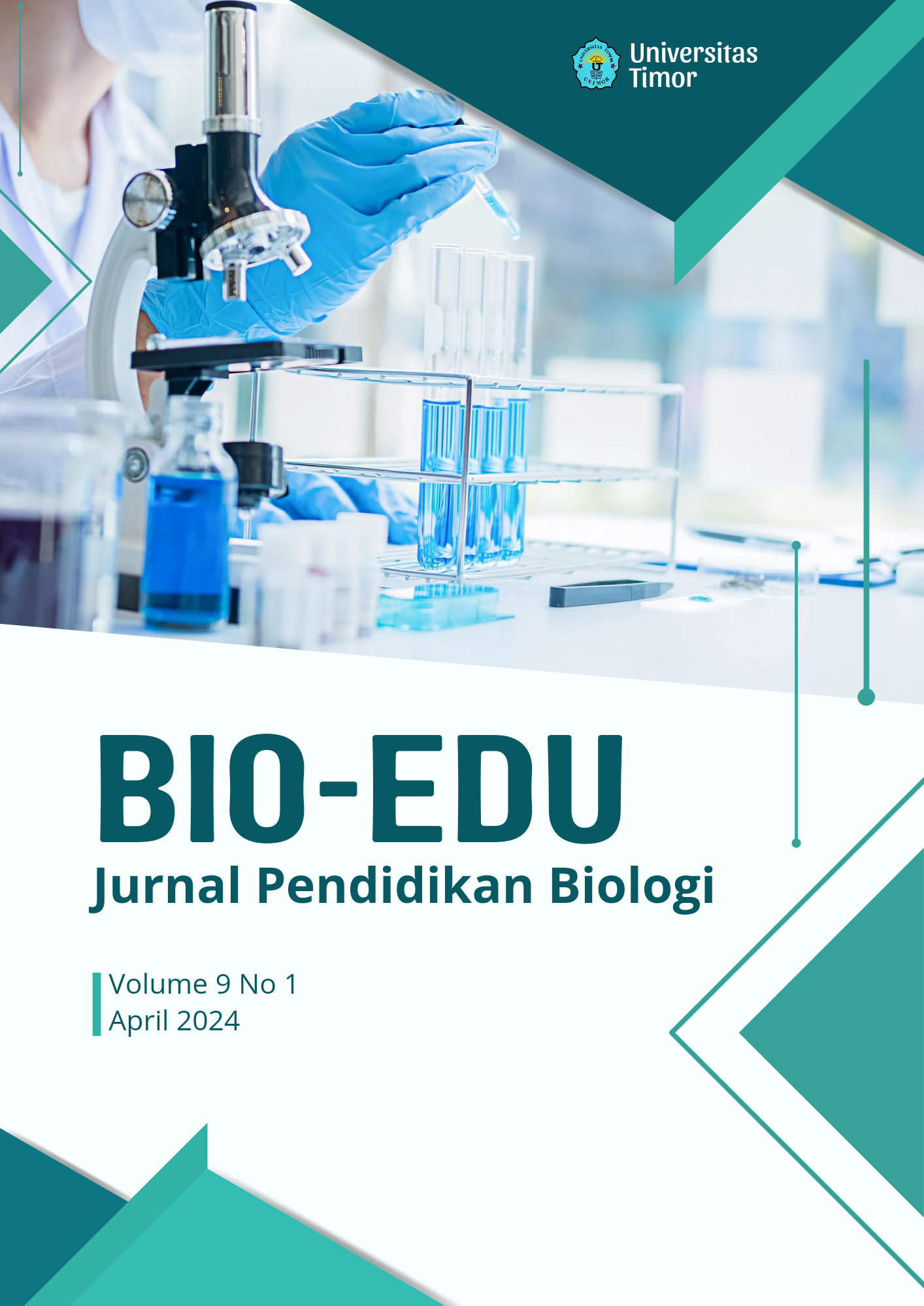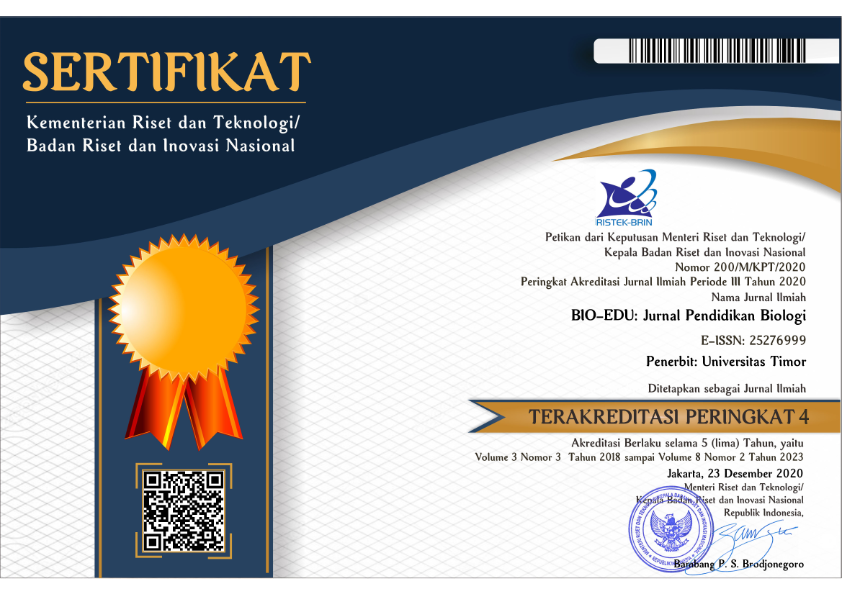Capung (Ordo: Odonata) di Kawasan Reklamasi Bekas Tambang Timah, Belinyu, Bangka
DOI:
https://doi.org/10.32938/jbe.v9i1.6568Keywords:
“Area Type”; “Bangka”; “Bioindicator”; “Dragonfly”; “Ex-Mined Land Reclamation”Abstract
Dragonflies are bioindicator insects that are known to be sensitive to the environment and their existence is influenced by habitat conditions. The potential of dragonflies as a bioindicator for the success of reclamation efforts for former tin mining on Bangka Island needs to be studied. This research aims to record the diversity of dragonflies and damselflies in reclaimed land covering an area of ±15.25 ha and aged ±16 years as one component to enrich the criteria for assessing the success of revegetation of ex-tin mining land. This research was conducted in the rainy season, January-March 2023. For three weeks, Schnabel's visual encounter survey (VES) and capture-mark-release-recapture (CMRR) methods were chosen to observe five transect lines, respectively non-revegetation areas, horticultural and fruit revegetation areas, oil palm revegetation areas, kolong with tilapia fish, and kolong with human activities. This research recorded 19 species of dragonflies and 6 species of damselflies, or around 6.5% of the dragonflies and 2.0% of the damselfly species on the island of Sumatra. The most dominant species are Neurothemis fluctuans and Ceriagrion cerinorubellum. The number of species and number of individual dragonflies is thought to be related to the age of reclamation, and has the potential to be an indicator of the success of ex-tin mining reclamation land.
Keywords:
“Area Type”; “Bangka”; “Bioindicator”; “Dragonfly”; “Ex-Mined Land Reclamation”
References
Acquah-Lamptey, D., Kyerematen, R., & Owusu, E. O. (2013). Using Odonates as Markers of the Environmental Health of Water and its Land Related Ecotone. International Journal of Biodiversity and Conservation 5(11), 761–769.
Alita. (2023). Keanekaragaman Jenis Capung (Ordo Odonata) di Kawasan Reklamasi Eks-Tambang Timah Air Nyatoh dan Hutan Jelutung, Kecamatan Belinyu, Kabupaten Bangka. [Skripsi]. Bangka Belitung: Universitas Bangka Belitung.
Bried, J. T., & Ervin, G. N. (2005). Distribution of Adult Odonata Among Localized Wetlands in East-Central Mississippi. Southeastern Naturalist 4(4), 731–744.
Buchori, D., Ardhian, D., Salaki, L. D., Pirnanda, D., Agustina, M., Pradana, E. W., Rahadi, W. S., & Nazar, L. (2019). Capung Kelola Sendang: Mengumpulkan yang Terserak, Merawat yang Tersisa. Zoological Society of London.
Dow, R.A. (2020). Ceriagrion cerinorubellum. The IUCN Red List of Threatened Species 2020: e.T167444A147082861. https://dx.doi.org/10.2305/IUCN.UK.2020-1.RLTS.T167444A147082861.en
Dow, R.A. & Wilson, K.D.P. (2017). Pseudagrion microcephalum. The IUCN Red List of Threatened Species 2017: e.T167199A83376119. http://dx.doi.org/10.2305/IUCN.UK.2017- 1.RLTS.T167199A83376119.en
Dwita, U. R., Ansori, I., Rahman, A., Jumiarni, D., Ruyani, A., & Abas. (2022). Pengembangan LKPD berdasarkan Keragaman Capung di Kawasan Danau Dendam Tak Sudah. Diklabio: Jurnal Pendidikan dan Pembelajaran Biologi 6 (1), 1–6.
Falcão, de. SA. R., Castellani, M. A., Ribeiro, A. E. L., Perez-Maluf, R., Moreira, A. A., Nagamoto, N. S., & Nascimento, A. S. (2012). Faunal Analysis of the Species Anastrepha in the Fruit Growing Complex Gaviao River, Bahia, Brazil. Bulletin of Insectology 65 (1), 37–42.
Fitria, F. (2019). Inventarisasi Capung di Habitat Alami (Sungai) dan Buatan (Kolong) di Kabupaten Bangka Selatan. [Skripsi]. Bangka Belitung: Universitas Bangka Belitung.
Futahashi, R. (2016). Color Vision and Color Formation in Dragonflies. Current Opinion in Insect Science 17, 32–39.
Gultom, S., Manalu, K., & Tambunan, E. P. S. (2020). Keanekaragaman Capung di Taman Wisata Alam Danau Sicikeh–Cikeh Desa Lae Hole Kecamatan Parbuluan Kabupaten Dairi Sumatera Utara. KLOROFIL 4(2), 55–61.
Ilhamdi, M. L. (2018). Pola Penyebaran Capung (Odonata) di Kawasan Taman Wisata Alam Suranadi Lombok Barat. Jurnal Biologi Tropis 18(1), 27–33.
iNaturalist. Diakses dari https://www.inaturalist.org/check_lists/4342242- Odonata-of-Indonesia, pada 16 April 2023.
iNaturalist. Diakses dari https://www.inaturalist.org/projects/odonata-of-sumatra-indonesia-dragonflies-and-damselflies?tab=observations, pada 16 April 2023.
Irawan, A., & Rahadi, W. S. (2018). Capung Sumba. Nusa Tenggara Timur: Balai Taman Nasional Manupeu Tanah Daru dan Laiwangi Wanggameti.
Isnaini. (2020). Studi Keanekaragaman Capung (Odonata) di berbagai Habitat di Pulau Bangka. [Skripsi]. Bangka Belitung: Universitas Bangka Belitung.
IUCN. (2022). Daftar Merah Spesies Terancam Punah IUCN. Versi 2022-2. diakses dari https://www.iucnredlist.org, pada 26 Juli 2023.
Khan, M. K. (2015). Dragonflies and Damselflies (Insecta: Odonata) of the Northeastern Region of Bangladesh with Five New Additions to the Odonata Fauna of Bangladesh. Journal of Threatened Taxa 7(11), 7795–7804.
Laily, Z., Rifqiyati, N., & Kurniawan, A. P. (2018). Keanekaragaman Odonata pada Habitat Perairan dan Padang Rumput di Telaga Madirda. Jurnal MIPA 41(2), 105–110.
Lino, J., Koneri, A., & Butarbutar, R. R. (2019). Keanekaragaman Capung (Odonata) di Tepi Sungai Kali Desa Kali Kabupaten Minahasa Sulawesi Utara. Jurnal MIPA Unsrat Online 8(2), 51–54.
Mitra, A. (2020). Orthetrum sabina. The IUCN Red List of Threatened Species 2020: e.T165470A83377025. https://dx.doi.org/10.2305/IUCN.UK.2020- 1.RLTS.T165470A83377025.en
Orr, A. G. (2001). An Annotated Checklist of the Odonata of Brunei with Ecological Notes and Descriptions of Hitherto Unknown Males and Larvae. International Journal of Odonatology 4(2), 167–220.
Pamungkas, D. W., & Ridwan, M. (2015). Keragaman Jenis Capung dan Capung Jarum (Odonata) di beberapa Sumber Air di Magetan, Jawa Timur. Pros Sem Nas Masy Biodiv Indon 1(6), 1295-1301.
Rahadi, W. S., Feriwibisono, B., Nugrahani, M. P., Dalia, B. P. J., & Makitan, T. (2013). Naga Terbang Wendit: Keanekaragaman Capung Perairan Wendit, Malang, Jawa Timur. Jawa Timur: Indonesia Dragonfly Society.
Ruslan, H. (2020). Keanekaragaman Capung (Odonata) di sekitar Kawasan Cagar Biosfer Giam Siak Kecil-Bukit Batu Riau. Bioma 16(1), 31–42.
Sukarman, & Gani, R. A. (2017). Lahan Bekas Tambang Timah di Pulau Bangka dan Belitung, Indonesia dan Kesesuaiannya untuk Komoditas Pertanian. Jurnal Tanah dan Iklim 41(2), 101–112.
Suprapto, S. J. (2008). Tinjauan Reklamasi Lahan Bekas Tambang dan Aspek Konservasi Bahan Galian. Buletin Sumber Daya Geologi 3(1), 20–32.
Susanto, M. A. D., & Putri, N. M. (2022). Inventarisasi dan Studi Komposisi Capung (Odonata) pada Area Persawahan Kelurahan Warugunung, Surabaya, Jawa Timur. Bio-Edu: Jurnal Pendidikan Biologi 7(1), 34–43.
Susilowati, O. (2023). Ragam Odonata di Belantara Kota. diakses dari https://balaiksdasumsel.org/ragam-odonata-di-belantara-kota, pada 23 Agustus 2023.
Waryati & Triatmanto. (2022). Keanekaragaman Capung (Ordo: Odonata) di Wana Wisata Curug Cipendok Kabupaten Banyumas Provinsi Jawa Tengah. Jurnal Sains Dasar 11(2), 101–108.
Yuditaningtyas, M., Hadi, M., & Tarwotjo, U. (2022). Struktur Komunitas dan Habitat Odonata di Kawasan Wisata Waduk Jatibarang Semarang. Bioma 24(1), 73–79.
Zaman, M. N., Fuadi, B. F., & Luthfika, M. (2022). Struktur Komunitas Capung dan Capung Jarum di Sungai Gajah Wong Segmen Perkotaan Daerah Istimewa Yogyakarta. BIOVERITAS Journal of Biology 01(01), 31–36.
Downloads
Published
Issue
Section
License
The Authors submitting a manuscript do so on the understanding that if accepted for publication, the copyright of the article shall be assigned to BIO-EDU: Jurnal Pendidikan Biologi and Departement of Biology Education, Universitas Timor as the publisher of the journal. Copyright encompasses rights to reproduce and deliver the article in all form and media, including reprints, photographs, microfilms, and any other similar reproductions, as well as translations.
BIO-EDU journal and Departement Biology Education, Universitas Timor, and the Editors make every effort to ensure that no wrong or misleading data, opinions, or statements be published in the journal. In any way, the contents of the articles and advertisements published in BIO-EDU are the sole and responsibility of their respective authors and advertisers.
Users of this website will be licensed to use materials from this website following the Creative Commons Attribution-ShareAlike 4.0 International License.



















